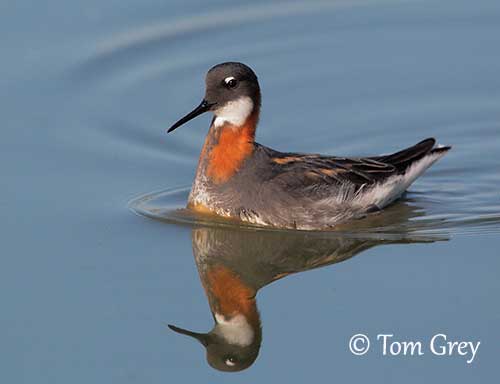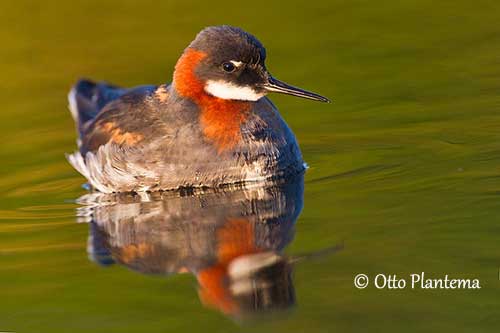
Fr : Phalarope à bec étroit
Ang : Red-necked Phalarope
All : Odinshühnchen
Esp : Falaropo Picofino
Ita : Falaropo beccosottile
Nd : Grauwe Franjepoot
Sd : smalnäbbad simsnäppa
Photographers :
Jean Michel Fenerole
Photos d’Oiseaux du monde
Tom Grey
Tom Grey's Bird Pictures & Tom Grey's Bird Pictures 2
Tom Merigan
Tom Merigan’s Photo Galleries
Otto Plantema
Trips around the world
Ingo Waschkies
Bird Photography
Text by Nicole Bouglouan
Sources :
HANDBOOK OF THE BIRDS OF THE WORLD Vol 3 by Josep del Hoyo-Andrew Elliott-Jordi Sargatal - Lynx Edicions - ISBN : 8487334202
SHOREBIRDS by Peter Hayman, John Marchant and Tony Prater – Christopher Helm – 1986 – ISBN: 0747014035
THE HANDBOOK OF BIRD IDENTIFICATION FOR EUROPE AND THE WESTERN PALEARCTIC by Mark Beaman, Steve Madge - C. Helm - ISBN: 0713639601
GUIDE DES LIMICOLES de D. Taylor - Delachaux et Niestlé - ISBN : 2603014080
ENCYCLOPEDIE DES OISEAUX DE FRANCE ET D’EUROPE – de Peter Hayman et Rob Hume - Flammarion – ISBN : 2082009920
THE COMPLETE BOOK OF BRITISH BIRDS – Written by “Royal Society for the Protection of Birds” experts - Préface de Magnus Magnusson - Michael Cady- Rob Hume Editors - ISBN: 0749509112
What Bird-The ultimate Bird Guide (Mitchell Waite)
The Birds of North America online
Animal Diversity Web (University of Michigan Museum of Zoology)
Bird Web (Seattle Audubon Society)
Neotropical Birds – Cornell Lab of Ornithology
BBC News – ‘Unique’ bird migration discovered
Red-necked Phalarope
Phalaropus lobatus
Charadriiformes Order – Scolopacidae Family
INTRODUCTION:
The Red-necked Phalarope is the smallest of the three species, compared to the Wilson’s Phalarope and the Red Phalarope.
During the breeding season, the roles are reversed. The female is larger and has brighter plumage than male. She initiates the courtship and is usually polyandrous. She does not take part in nesting duties, and the male incubates and rears the chicks alone.
The Red-necked Phalarope has circumpolar range and breeds in coastal areas of Arctic Ocean. It winters at sea in open water. On passage during migration, it can be seen by shores of large lakes and small pools.
The species is not currently globally threatened. Like numerous Scolopacidae, climate change may have significant negative impact on some breeding populations.

DESCRIPTION OF THE BIRD:
Biometrics:
Length: 18-19 cm
Wingspan: 32-40 cm
Weight: 36 g (28-40)
The Red-necked Phalarope adult female in breeding plumage has dark grey-brown upperparts with golden-buff lines bordering mantle and scapulars. The larger scapulars, coverts and tertials have rufous-buff edges. On the upperwing, we can see a narrow, white wingbar. Rump and tail are dark grey, with whitish sides to the rump.
On the underparts, breast band and flanks are grey. The rear flanks are white with dark grey spots. Belly and undertail are white. On the white underwing, there is a dark bar across the median underwing-coverts.
Head and neck are dark grey to blackish. The white chin and throat are usually outlined with grey. A chestnut-red band extends from behind each eye down sides of neck to join across the foreneck base. This collar is bordered below by the dark grey breast band.
The bill is fine, needle-like, and slightly downcurving towards the tip. The eyes are brown, with white crescent above. Legs and feet are blue-grey to dark grey. The toes are distinctly lobed to help the swimming bird. This peculiar morphological feature gives the bird the name “lobatus”.
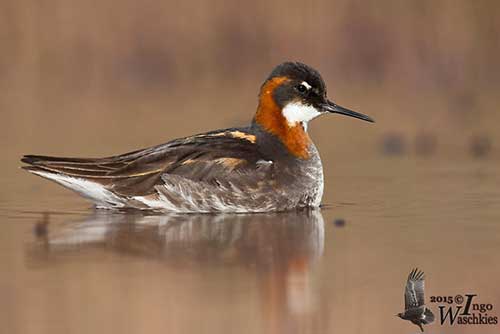
The adult male in breeding plumage is much duller. It has dull brown-grey face, crown and breast. The white spot above the eye forms a short white supercilium. The upperparts are paler brown with more edged-buff feathers on mantle. The neck patch is duller, mostly pale rusty-brown.
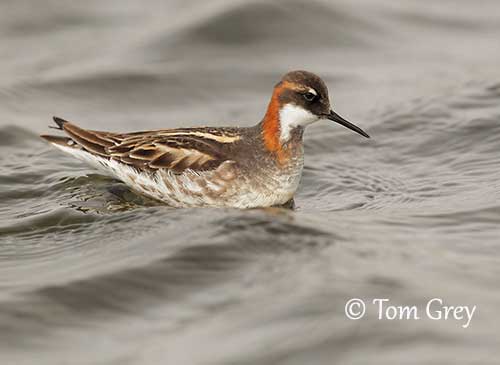
The non-breeding adult has dull pale grey upperparts with white fringing on hindneck, mantle, scapulars and wing-coverts. The underparts are white with indistinct streaking on lower flanks and breast sides. The head is white with variable extent of blackish-grey. We can see a black crescent through and behind the eye.
The juvenile has blackish-brown crown, hindneck, mantle, scapulars, coverts and tertials, with broad buff fringes. The underparts are white, but face, neck sides and upper breast show pinkish-buff tinge. The head resembles non-breeding adult.
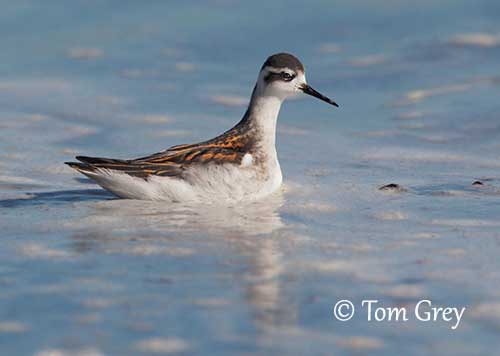
RANGE:
The Red-necked Phalarope has circumpolar breeding range and breeds in coastal regions of Arctic Ocean in North America and Eurasia, S to Aleutians and British Islands.
It is pelagic during winter and can be seen off CW South America, in Arabian Sea, and from C Indonesia to W Melanesia.
HABITAT:
The Red-necked Phalarope breeds on Arctic and sub-Arctic tundra, usually by moorland bogs, on marshy edges of ponds, lakes and pools. On passage, it frequents the shores of freshwater lakes and small pools. It is highly pelagic in winter, during which they gather over upwellings or around kelp beds with high abundance of plankton.
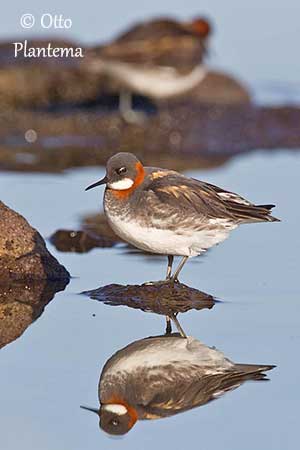
CALLS AND SONGS: SOUNDS BY XENO-CANTO
The Red-necked Phalarope utters a short, sharp, often repeated “kip”, also a harsh “cherp” and a Common Coot-like “kerrek”. During the breeding season, it produces various warblings and twittering calls.
BEHAVIOUR IN THE WILD:
The Red-necked Phalarope’s diet varies according to season and habitat, but it usually feeds on insects, crustaceans and mollusks. During the breeding season, it consumes primarily insects, adults and larvae, of various species. It feeds on shrimps at stopovers on alkaline lakes. During winter at sea, it consumes small crustaceans of genus Euphausia and mollusks.
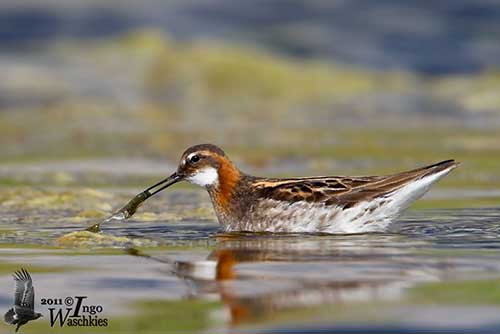
The Red-necked Phalarope forages mainly by swimming while picking food items from the water surface or just below it. Several birds may forages together, each bird swimming while circling rapidly on shallow water to bring prey close to the surface. They feed very quickly on small prey.
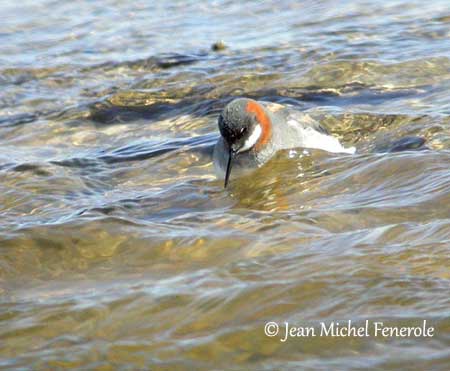
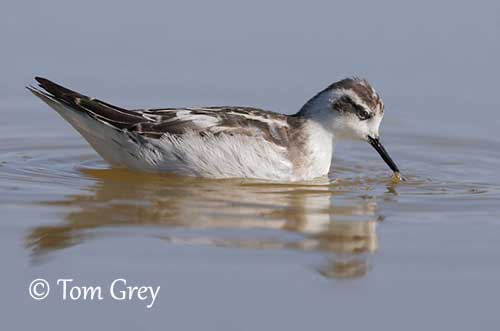
During the breeding season, the female takes the lead in courtship, making short flights on whirring wings accompanied by calls. On water, she swims around the male which is reluctant first, but it shows gradually interest and finally follows the female. The copulation may occur in the water.
They are monogamous, although females are often polyandrous. The female leaves the male after the laying, and mates with other males. The brood is tended by the male alone.
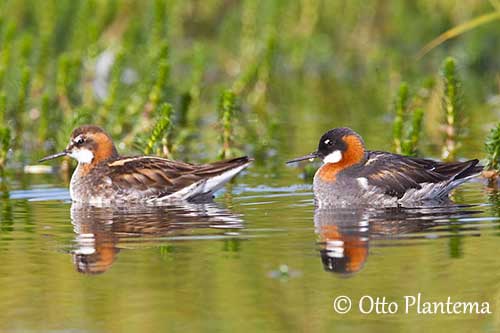
The Red-necked Phalarope is migratory, with females leaving the breeding grounds in late June, while males follow in late July and juveniles mostly in August-early September. They migrate partly overland and make some stopovers at lakes where they stop in large flocks.
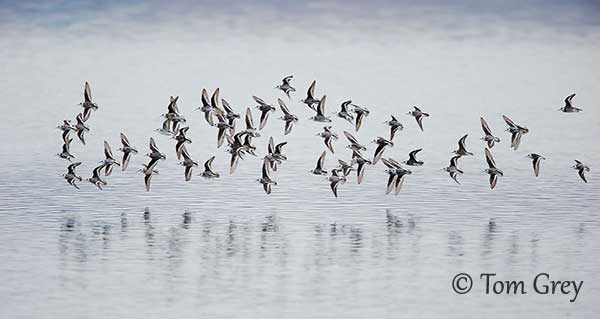
The Red-necked Phalarope has swift, shallow flight with rapid wingbeats. It often turns and zigzag low over water, in fast, erratic flight.
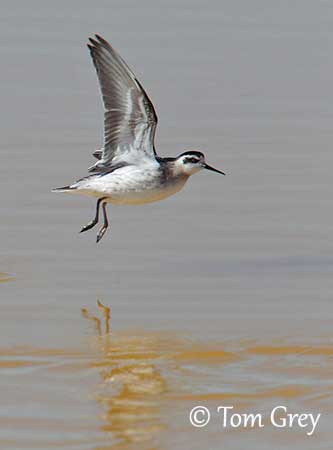
REPRODUCTION OF THIS SPECIES:
The breeding season takes place in spring, with the laying in June in Fennoscandia, and from mid-May in North America.
The Red-necked Phalarope nest solitary, and sometimes in loose colonies of up to 50 pairs with nests about 2-3 metres apart in restricted habitat.
The nest is on the ground and often near water in low vegetation. It is a shallow depression lined with leaves and grass. Male and female make several scrapes and the female selects one, and then, both adults build the nest.
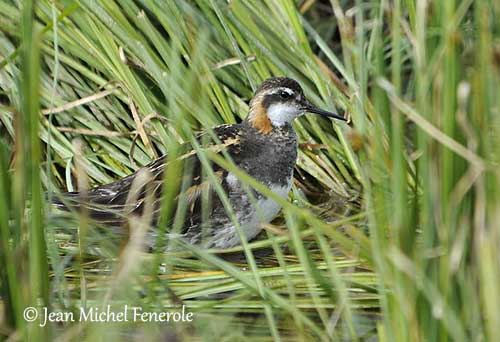
The female lays 3-4 olive to buff eggs with dark brown markings. The incubation lasts 17-21 days by the male alone. The chicks leave the nest very soon after hatching, usually within 24 hours, and reach the shore of the water with the male. It broods them and tends them during the first days, but the chicks are able to feed themselves. The male leave the area after two weeks, and the young fledge about three weeks after hatching.
PROTECTION / THREATS / STATUS:
The Red-necked Phalarope has decreasing populations throughout the wide range, due to natural events such as El Niño and climate change.
The global population was estimated to number 3,600,000/4,500,000 individuals in 2006.
The Red-necked Phalarope is currently evaluated as Least Concern.
